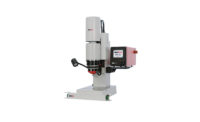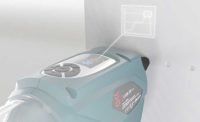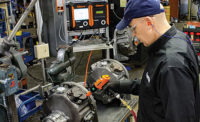Inventors of manufacturing technology have many sources of inspiration. One is human anatomy, which has led to the development of things like hand-like grippers and collaborative robots. Another is commercial technology that is used in toys.
Drawing toys based on gears have been around since the early 1900s, beginning with the little-known Marvelous Wondergraph. The well-known Spirograph wasn’t introduced until the mid-1960s.
By then, however, American and European manufacturers were using radial forming to assemble many types of products. This technology uses a Spirograph-type process to form heads on rivets and posts.
“The peen tool in a radial forming machine moves along a path that’s comparable to the Spirograph,” explains Chuck Rupprecht, general manager at BalTec Corp. “In every application, the tool moves radially outward and inward, and tangentially overlaps in an 11-point rosette pattern. This ensures uniform forming of the rivet material with the least possible force.”
Recently, BalTec provided a RN-181R radial forming machine to a surgical toolmaker to form a small rivet on the clamping mechanism of endoscopes. The rivet is less than 1 millimeter in diameter and requires precise forming to allow consistent clamp movement.
According to Rupprecht, the machine is used with BalTec’s HPP-25 process controller, which monitors data from force and distance sensors to ensure that the rivet undergoes no shank swelling. Equally important, the rivet is formed to a specific diameter and height to guarantee flexible movement of the clamping device. Forming force is below 337 pounds.
Besides medical tools, radial forming is extensively used in automotive, high-end electronics and several other industries. The same can be said of orbital forming, a sister technology that’s better suited for riveting larger-diameter parts. Both of these cold-heading processes eliminate loose rivets from an assembly operation—and do so more reliably, consistently and cost-effectively than ever.
Round and Round it Goes
“In reality, about 97 to 98 percent of our customers’ applications can be completed with either orbital or radial forming,” notes Bryan Wright, vice president of sales at Orbitform Group. “Both methods eliminate the need for fasteners, and are capable of joining similar and dissimilar materials like metal, plastic, glass, ceramics and composites. But, end-users often choose orbital forming to save on maintenance and tool-replacement costs.”
An orbital forming machine features a rotating spindle with a mounted peen tool fixed at a 3- or 6-degree angle to the spindle axis. The machine begins forming after the mating parts are positioned over a cast or machined-in rivet, post, pin or ridge. This protrusion can be solid, tubular, triangular, square, hexagonal, oblong or semicircular.
As the spindle rotates, the peen orbits the spindle axis. The peen does not rotate on its own axis, but presses on the rivet shank along a radial line that begins from the shank center. As the peen moves in an orbital path, a minute quantity of material is displaced with each rotation of the forming head until forming is complete.
Because the line of contact on the peen to the workpiece is always the same, and the orbital head features a series of bearings, friction between the two is minimal and there is no tearing of the work material. In addition, the workpiece is normally cool to the touch after forming. The forming time is 0.5 to 4 seconds, depending on material type, stud diameter, desired head style and stroke length.
Spindle rotation speed can vary from 900 to 1,200 rpm, with 1,140 rpm used most often, and some units being capable of reaching up to 3,400 rpm, according to Wright. The bearings in the head enable it to withstand such a high rpm if the application demands it.
The peen is made of heat-treated steel and held in place by a setscrew, so it can be changed quickly. Changing the shape of the peen changes the shape of the finished rivet head. Conical, flat, eyelet and crown are some common head shapes. Others include flared, flat-flared, swaged, shoulder, cambered, ring stake, high crown, roll-in and draw-in.
Traditionally, the downward force applied by orbital and radial forming machines has come from pneumatic or hydraulic cylinders. However, Orbitform and BalTec also offer servo-driven power heads. Using a servomotor and ballscrew to apply downward force confers numerous advantages, such as precise control, variable advance and retract rates, and a wide range of forming forces.
The level of forming force depends on the application, with current models producing up to 38,500 pounds. Stroke length on pneumatic and hydraulic machines ranges from 0.08 to 2.5 inches, whereas electric units have a stroke length up to nearly 8 inches. The spindle stroke is typically controllable within increments of 0.001 inch.
More than one point on a part can be formed at the same time with a multi-spindle head, which is an orbital head with two or more peens. A multi-spindle head can be used to support points to be formed with a centerline distance from 0.3125 to 6.25 inches apart. A multipoint head uses an orbiting thrust-plate to transfer the motion to multiple rotating peens.
For added flexibility, a single-point machine can be retrofitted with a multipoint head, as long as the total aggregate forming capacity stays within the powerhead forming capacity. There is no specific limit on how many points can be formed simultaneously on one part, but the center lines of the points must be a minimum of 0.3125 inch apart.
The benchtop pneumatic model T-251 from Taumel Assembly Systems orbitally forms rivets of mild or solid steel up to 0.25 inch diameter. Phil Huber, product manager and sales rep at Taumel, says the machine’s control panel allows for an infinitely adjustable cycle time up to 5 seconds and headforming pressure. Stroke length is 0 to 1.25 inches in 0.001 inch increments. Standard air supply is 60 to 90 psi.
Fully automatic or semiautomatic cycling is possible, and users can choose from different proximity touch pads to initiate the forming cycle. The OSHA-compliant machine features simple tooling for easy setup, and a built-in pressure indicator and circuitry that allows for two-handed safety controls.
Orbital forming equipment can handle mild steel shanks as small as 0.02 inch or larger than 1.25 inches. With special tooling, orbital forming equipment can swage or flare assemblies exceeding 3 inches in diameter. Wright notes that Orbitform’s orbital-forming machines are used by manufacturers in automotive and 13 other industries, and several companies have orbital-formed rivets or posts up to 1.5 inches in diameter.
Orbitform began making servo-driven powerheads in 2011, and its latest three models are the SV315, SV515 and SV715. All the heads are available for use as a benchtop model or incorporated into a larger system. Forming force capacity of the SV315 is 2,200 pounds, the SV515 is 4,400 pounds, whereas the SV715 reaches up to 7,510 pounds on a mild-steel solid rivet from 0.03 to 0.84 inch in diameter.
Wright says all the heads can be used for orbital and radial riveting, and produce precise articulating joints. The heads have a 6-inch stroke and an advance or retract rate of 0.005 to 4 inches per second.
Spring-loaded parts or loose assemblies are no problem for orbital forming, say suppliers. The parts are held in place with spring-loaded devices, called pressure pads, that fit around the spindle and extend below the peen. Because they extend below the peen, they contact the workpiece first, holding it in place.
According to Huber, any malleable material up to Rockwell 35C can be orbitally formed. This includes most ferrous and nonferrous metals, stainless steel, zinc, brass, copper, die-cast aluminum, some sintered metal, and many types of engineering thermoplastics.
Orbital forming is regularly used to assemble brake linings for commercial vehicles, various types of latches, window and door furniture, and textile and leather goods. The technology is also used in the assembly of electrical and electronic components.
Wright says the main benefit of orbital riveting is it forms rivets using around 80 percent less force than that of a standard press. This results in less power consumption and reduces internal stress on the fastener and joint assembly, thereby eliminating cracks caused by traditional riveting and making it less likely to fatigue in the field.
One of the main considerations with orbital riveting is it requires fixturing to support the workpiece from side-load forces (about 10 percent of the forming force). With radial forming, side load forces are not an issue. Also, the process always produces some scuffing and galling of the rivet as the tooling wears.
“This is evident in embossing applications, although an antirotation device can alleviate this somewhat,” notes Wright. “The device is also needed to be able to properly form rivets that are 0.125 inch diameter and smaller, and if located close to a side wall feature.”
Grant Riveters USA offers a series of pneumatic benchtop orbital riveters that perform 2 million to 6 million cycles before needing part replacement and are hard-chromed inside for extra durability. Five models are available, with a maximum downward force of 480 to 7,760 pounds at 80 psi. Their stroke is adjustable from 0 to 1.181 inches or 1.771 inches.
Model 3 handles 1018 steel rivets up to 0.0118 inch diameter, model 5 to 0.196 inch, model 8 to 0.315 inch, model 12 to 0.472 inch and model 16 to 0.63 inch. Typical cycle time is 0.5 to 1.5 seconds. All the riveters are multi-process units capable of orbital, twin-spin, multi-spin and spin-press forming.
Loopy But Effective
Radial forming is often confused with orbital forming because the two processes share many similarities. Both form heads on rivets, pins and posts; produce high-quality joints; and can be adapted to work in close quarters and readily integrated into semiautomatic or fully automatic assembly systems.
There are two main differences, however. One is that radial forming can hold a joint within tighter tolerances. The other is the process itself.
With radial forming, the peen axis is not held at a fixed angle with the spindle axis. The working end of the peen passes over the end of the rivet shank on a path that is an 11-loop rosette. The angle between the peen axis and spindle axis varies continuously between 0 to 5 degrees, but is typically 3 or 5 degrees. The angle between the two is 0 degrees when the axes are aligned.
In addition, the peen rotates as it orbits the rivet. Forming pressure is applied following the rosette pattern, so the pressure line on the peen moves repeatedly through the common centers of the peen and the rivet shank. The process of the peen pressing against the rivet shank spreads the rivet material radially outward, radially inward and tangentially overlapping.
Rupprecht says that this kneading action may improve the conductivity of metal parts. For this reason, radial riveting is often used to form heads for electrical contacts.
“Nine out of 10 applications we do involve radial forming, and they cover a wide range of industries,” says Rupprecht. “There’s precision electronics, like cell phones, as well as circuit breaker assemblies. Ladder manufacturers use the process to form rivets to hold rungs in place, and window makers radially form rivets for cranks in encasement windows. Hand tool and knife companies use radial forming in many applications as well.”
These smaller applications complement BalTec’s large-capacity applications like automotive, aerospace and white goods manufacturers. Door locks, hood latches, brake-pad clips, air-bag igniters and seat-reclining mechanisms round out the list of auto parts that BalTec radial forming machines assemble. Applicable plane parts include overhead bin hinge assemblies, friction plates on brake pads, and seat rest and belt assemblies. As for white goods, there are rotors in washing machines, and rivets on wheels that move racks in and out of dishwashers.
The main advantage of radial forming is that is does not deform the molecular structure of the metal as much as other riveting processes. It can also form nonround applications, such as a shaft with a single or double D shape, which often requires high torque.
“By placing low stress on the components, radial forming allows for processing of products that contain Bakelite, ceramic and other brittle materials,” points out Rupprecht. “Also, minimal lateral forces allow for simple workpiece holding, usually without the need for clamping.”
Last year, BalTec introduced its ER15 electric power module for radial and orbital forming. Efficient and compact, the module features two servo-driven motors (placed inline) and offers high-precision, direct monitoring of force, stroke and temperature.
The module has a maximum forming force of 15 kilonewtons and a stroke length of 5 to 100 millimeters. It comes in a plug-and-run package with drives, a PLC and the company’s HPPi process control software.
Later this year, BalTec will expand its Electric line to include a higher-capacity machine for larger-diameter applications, and a smaller machine for small, high-precision assembly applications.






